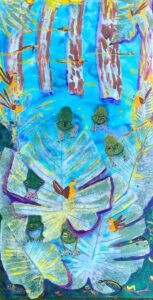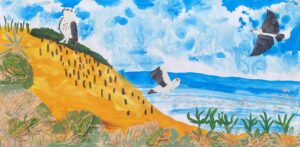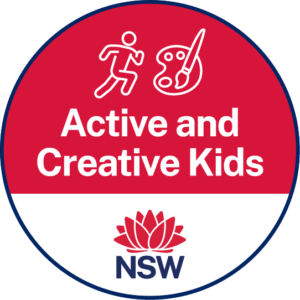This term at Art Box Workshops, our students have brought two precious ecosystems — Hanging Swamps and the Kincumber Wetlands — to life through art.
Both projects were inspired by Julia’s recent learning on the NSW Central Coast, where she attended Jake Cassar’s Bushcraft and Nature Care course at Walkabout Wildlife Sanctuary and visited the Kariong Sacred Lands. There, she helped clear introduced species along the roadside and learned about the unique Hanging Swamp habitats found in this area. These experiences deepened our understanding of local, community-led efforts to protect endangered places, such as the Hanging Swamps and the wetlands near Kincumber.
Back at our Neutral Bay studio, our students explored how these fragile places help our environment thrive. Hanging Swamps, for example, act as natural sponges — absorbing and releasing water to nourish streams, prevent erosion, and support countless small birds, frogs, lizards, insects, and rare plants. The Kincumber Wetlands, meanwhile, filter water, provide flood protection, store carbon, and shelter threatened species like the Eastern Osprey and the Green and Gold Bell Frog.
Our youngest artists (ages 6–8) learned to sketch and paint these species using our handmade Earth Mineral Paints, created in the studio with plant-based binders. They also experimented with printmaking, using small leaf cuttings gathered from local nature corridors to create beautiful prints on rice paper — a reminder that creativity and sustainability can go hand in hand.

Southern Emu Wren’s play in the nurturing Heart of the bushland.
Mother Nature’s nurturing Heart of the bushland is hanging swamps, a suspended wetland. That holds essential water like a sponge that pulses out life to the bush below.
The Southern Emu-wren has a wispy tail, reminiscent of tiny emu feathers, that stands out with its bright yellow, blue, and earthy red feathers. Each student painted it as the main character, collaged inside the circular hanging swamp sanctuary. Flying and perching among symbolically chosen heart-shaped leaves that were hand-printed and collaged to hold a protective place for water skinks and giant frogs that burrow and hide in soft, green foliage and cool, wet soil.
Created by Lottie C, Willa L, Piper P, Simon Ng, Dulcie R, Savanah C, Amelia S, and Jack G,
Medium: Handmade earth mineral paints on paper.
Dimensions: H1480 mm x W785mm.

Community strength and resilience – Kincumber Wetlands.
As an environmental art educator, I attend nature care courses on the central coast of NSW. This year, Kincumber wetlands became a focal point for my students’ creative project, as it is currently under threat of being leased for development by the local land council. Our students learned about the sensitive wetland ecosystem of Kincumber, which helps shield vulnerable wildlife, such as the Green and Gold Bell Frog, that relies on the wetland’s natural water filtration and flood mitigation functions to survive and thrive in the lush environment. Our young artists learned about natural design and the remarkable strength and resilience of the intricate, interwoven vegetation found in salt marshes and mangroves, which serve as homes to many species that live in harmony. Our students’ paintings will serve as a visual testament to celebrate the Kincumber wetlands.
Created by Lexi C, Karen D, Esther D, Gabriel M, Abby G, Norbert D, and Letong Z,
Medium: Handmade earth mineral paints on paper.
Dimensions: H 750 mm x W 1480 mm
It will be proudly displayed at North Sydney Council Chambers during our Annual Student Exhibition — a testament to the power of children’s creativity to inspire genuine care for the natural world.
Printmaking with Purpose
Our older primary students embraced the art of block printing in our Term Two printmaking course. Inspired by the work of renowned Australian artist Margaret Olley, each student created a unique print of their favourite native species and hand-painted it using our Earth Mineral watercolours.
Some of their beautiful works include:
- Eastern Dwarf Tree Frog by Mia P, Jazlyn C, and Nayantara R
- Green and Gold Bell Frog by Anjali J
- Eastern Greater Glider by Erina
- Blue Mountains Water Skink by Lottie S and Edward Z
- Orange-bellied Parrot by Sofia D, Tom S, and Eloise K
- Regent Honeyeater by Claudia O
- Pygmy Possum by Winter O.B
- Pink Robin by Tina X
- Birds of Sydney by Grayson R
- Bellingen Turtle by Alice
This series of prints shows the growing connection our students have with local wildlife and their desire to share these stories through art.
We are so proud of all our Term Two artists for using their creative skills and imagination to help bring awareness to creatures and ecosystems that cannot speak for themselves. Little Sanctuary, Living Wetland, and our block prints remind us that protecting what is precious today means hope and life for tomorrow.
Thank you to our excellent students and families for helping bring these messages to life — may your work inspire others to care for these fragile environments and the remarkable species they shelter.

